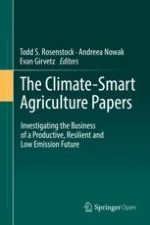26.1 Introduction
26.2 Theories of Change
26.3 Evidence Base
CSA practice | CSA typea | Case | Evidence |
|---|---|---|---|
Pathway 1: Input intensification and investment
| |||
Land management practices: manure or compost, burning to clear the plot, contour ploughing, reduced tillage, intercropping or mixed cropping | Carbon-nutrient smart | Pender and Gebremedhin (2008) on smallholders in Ethiopia | Credit is not strongly associated with the use of land management practices |
Adapting aquaculture practices (e.g., water management in ponds, shifting production calendar) | Water-smart | Arimi (2014) on fish farmers in Nigeria | Fish farmers with access to credit showed higher adoption rates of adaptation measures |
Conservation practices that reduce soil erosion and increase yields | Carbon-nutrient smart | Marenya et al. (2014) on small farmers in Malawi | Most farmers preferred cash payments to index insurance contracts, even when the insurance contracts offered substantially higher expected returns. Further, more risk-averse farmers were more likely to prefer cash payments |
Pathway 2: Income and expenditures
| |||
Changing crop varieties, soil and water conservation measures, water harvesting, tree planting, change planting and harvesting dates | Seed-breed smart, carbon-nutrient smart, water-smart | Di Falco et al. (2012), cereal farmers in Ethiopia | Access to formal credit had a positive but not significant effect on the adoption of the practices |
Planting of agro-forestry trees, change of date of planting, land terracing, construction of drainages, cover cropping, making ridges across slope, selling assets, borrowing loans, diversifying livelihoods, short-term migration, support from social network, compensation of losses from government | Weather-smart, water-smart, carbon-nutrient smart, institutional-market-smart | Enete et al. (2016) on flood-coping strategies of small farmers in Nigeria | Access to credit had a negative relationship with selling of assets and short-term migration, suggesting that farmers do not need to recur to more radical and expensive coping strategies when they have access to credit |
Maize-legume intercropping, soil and water conservation measures, organic fertilizer, inorganic fertilizer, high-yielding maize varieties | Carbon-nutrient-smart, seed-breed-smart | Arslan et al. (2016) on maize farmers in Tanzania | Positive effect of credit for practices that require liquidity (inorganic fertilizer, improved seeds). Negative effect of credit for intercropping, probably because intercropping is perceived as a way to compensate for lack of fertilizers. Credit appears to increase the use of modern inputs but decrease maize-legume intercropping, a practice that has which has longer-term benefits for soil health and adaptation |
Pathway 3: Risk mitigation
| |||
Diversity of climate change adaptation practices | Weather-smart, water-smart, seed/breed-smart, carbon-nutrient-smart, institutional/market-smart | Shackleton et al. (2015) reviewing evidence from 64 case studies worldwide | The cluster “financial, technical and infrastructural barriers” is the most cited barrier. This includes lack of cash and lack of credit, but also lack of inputs and poverty in general |
Forest sequestration (mitigation), CSA (adaptation) and information-communication (disaster management) | All | Wong (2016) reviewing evidence from a variety of case studies worldwide | Women face more obstacles in accessing credit and cash, preventing them from adopting certain practices. Existing policies have not paid sufficient attention to the gender gap in access to land, capital and other productive resources. Engaging women in CSA without fully understanding the constraints they face risks reinforcing their subordinated positions |
Crop diversification, adjustment of crop management practices or agricultural calendar, land use and land management, and other strategies | Weather-smart, carbon-nutrient-smart, institutional/market-smart | Yegbemey et al. (2014) on maize farmers in Benin | Access to credit enables the farmer to choose adaptation strategies that require investments (larger doses of fertiliser, purchase of better seeds, etc.) |
26.3.1 Input Intensification and Investment Pathways
26.3.2 Income and Expenditures Pathway
26.3.3 Risk Mitigation Pathway
26.4 Complementarities
26.5 Implications for Development
-
A broad use of CSA practices cannot be based on single financial products but requires the development of integrated financial markets.
-
Effectiveness of rural finance for CSA upscaling is heavily supported by the combined offer of finance with technical assistance and business support.
-
Prospects for scaling of CSA practices increase alongside coherent public investments in market development and institutional arrangements.
-
Combined public and private sector engagement in CSA investments may have an additional payoff since such joint efforts also contribute to a more resilient business climate.
-
Blended finance can take shape in the form of softer financing conditions for climate-smart investments (e.g., risk-sharing, risk layering, interest rates rebates and longer repayment periods), performance clauses and prohibitions, and combinations of finance with subsidized interventions (e.g., training, technical assistance, business development services and certification).
